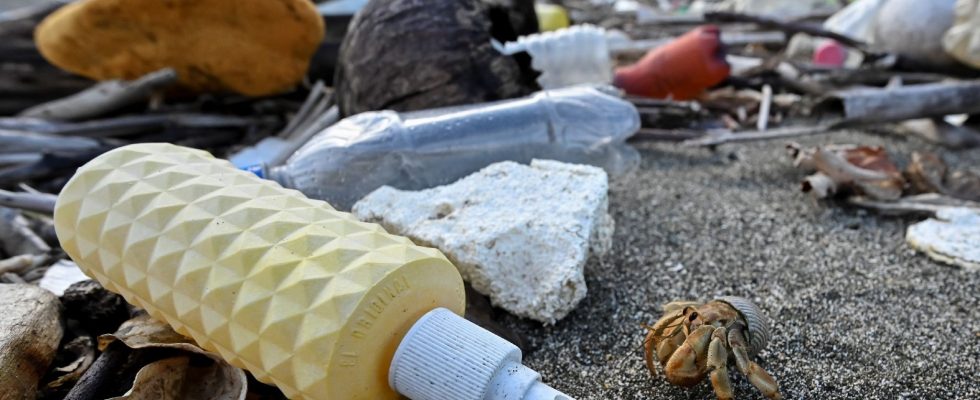It is both an environmental and public health issue: plastic, this multicolored material that has revolutionized industrial production and consumption habits, has invaded the planet. This Saturday, May 27, the ministers and representatives of some sixty countries met informally at the Paris headquarters of Unesco to prepare the international negotiations supposed to put an end to the global crisis of plastic pollution.
These negotiations, which will take place from Monday May 29 to Friday June 2 in Paris, aim to reach a crucial treaty for ecological transition. Promised by the UN since March 2022, this text must be “legally binding” and see the light of day before the end of 2024. After initial technical negotiations at the end of 2022 in Uruguay, the French capital is hosting the second session of negotiations, of the five planned. The debates promise to be tense.
The site is gargantuan, since this material from petrochemicals now suffocates all corners of the planet, from open landfills, to the bottom of the oceans and to the tops of mountains. Present in all everyday objects (packaging, clothing fibers, construction equipment, medical tools), it creates waste that endangers human health as much as the environment. Plastic has been found in the stomachs of birds before, and numerous studies have shown that microplastics have been detected even in the blood, in breast milk, or even in the placenta. Plastic accounted for 1.8 billion tonnes of greenhouse gases (largely responsible for global warming) in 2019, or 3.4% of global emissions. And this figure could more than double by 2060, according to the OECD.
Recycling or reduced production?
A question will be at the center of the debates. For the time being, the principle resolution adopted by the UN in 2022 aims only to “promote the production and sustainable consumption of plastic”, as well as the “reduction of plastic pollution in the marine environment”. But a coalition of 55 countries is convinced that it is essential to go further, otherwise the treaty will remain ineffective. They highlight the urgency of “reducing use and production” in addition to increasing recycling rates, which they say will not be enough to drastically reduce pollution from plastics and microplastics.
Led by Rwanda and Norway, this coalition also includes the European Union, Canada, Chile and, since Friday, Japan and Gabon. Last month in Japan, the G7 had already set itself the goal of reducing plastic waste into the environment to zero by 2040. This goal is also hammered home by NGOs and scientists: they are demanding that the future treaty set a “global objective of reducing production by 75% by 2050”, and ask the States to adopt a “moratorium on new petrochemical installations related to plastic or their expansions”.
The French government, which claims to be one of the most ambitious in this area, is also positioning itself for a reduction in production. “If we increase our recycling rates, but at the same time we increase our production, we will have gone backwards in solving the problem. So, firstly we reduce, secondly we increase the share of recycling”, declared the Minister of Transition ecological Christophe Béchu, this Saturday. “Plastic is in nature and now it is in our lungs, so it is high time to stop this invasion, first by stopping the growth of plastic production,” added Foreign Minister Catherine Colonna, ahead of the debates. In particular, it is necessary to “eliminate single-use plastic, it is 40% of world production which is frankly useless”, she pleaded.
Other nations such as China and India, but also the United States, are much more reluctant to slow down production. They insist above all on recycling and the fight against waste abandoned in nature.
Petrochemicals lobby for recycling
Declining production is not on the agenda of the petrochemical giants either. While global plastic production has almost doubled in 20 years to reach 460 million tonnes per year, they predict a tripling by 2060. Currently, two-thirds of global production is thrown away after just one or a few uses. And only 10% is recycled.
The European Association of Plastics Manufacturers, “Plastic Europe”, promotes “the development of a global agreement which responds to the challenge of plastic waste” via a circular economy based on recycling, but not a drop in production. In 2022 during the first negotiation session, three of the largest companies in the sector, Bow, Ineos and BASF, had all announced investments in technologies allowing for more efficient and purer recycling, or easier to process plastic materials.
For some NGOs, such as Greenpeace, this massive investment in plastic responds to the existential uncertainty that is gaining the world of petrochemicals as the ecological transition begins. While “car manufacturers are investing heavily in electrical technology and local and national governments are beginning to program the banning of gasoline and diesel vehicles as well as domestic gas boilers”, points out the NGO in a report, “the big vertically integrated groups in the fossil fuel sector, such as Aramco, Total, Exxon and Shell” are well placed to want the continuity and development of the plastics sector, since “more than 99% of plastics are produced from fossil fuels “.
